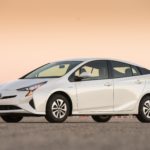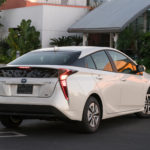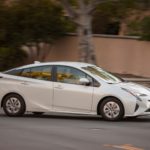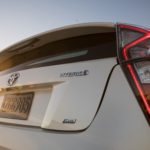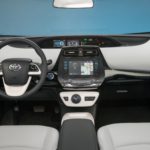 The Toyota Prius was revamped for the 2016 model year, and if you’ve had your eye on one, now might be the time to get serious about signing on the dotted line. As we edge toward New Year’s Eve, some Toyota dealers are discounting 2016 Priuses to make room for the 2017 models rolling into showrooms.
The Toyota Prius was revamped for the 2016 model year, and if you’ve had your eye on one, now might be the time to get serious about signing on the dotted line. As we edge toward New Year’s Eve, some Toyota dealers are discounting 2016 Priuses to make room for the 2017 models rolling into showrooms.
The Prius has come a long way from the noisy little battery startup that it was around the turn of the century. For starters, it really doesn’t look like a Prius anymore. Most people think of a Prius as being small and somewhat cocky but definitely something you can put in a box because it looked boxy. For 2016, the Prius has a racy look to it. It sits lower to the ground (be careful on speed bumps) and has a lot of engine fierceness that is quite surprising for a hybrid. Actually, the 2016 Toyota Prius looks sporty and sexy, and not in a naturalist kind of way. All the lines and the angles point to power inside and out, and it really is attractive.
 What jumps out at everyone is the incredible mileage that the basic Prius now offers: a combined 56 miles-per-gallon on the highway and city streets. That is almost unheard of and somewhat unbelievable, but this year, Toyota did it. They figured out how to make a car roar while keeping consumption low – a combination that would be great in a partner. Depending on how much you drive, that could easily shave $100 a month of your fuel consumption, which unfortunately will go to your student debt instead of your California cannabis fund. Still, the mileage just keeps getting better as our vehicles move deeper into the 21st Century.
What jumps out at everyone is the incredible mileage that the basic Prius now offers: a combined 56 miles-per-gallon on the highway and city streets. That is almost unheard of and somewhat unbelievable, but this year, Toyota did it. They figured out how to make a car roar while keeping consumption low – a combination that would be great in a partner. Depending on how much you drive, that could easily shave $100 a month of your fuel consumption, which unfortunately will go to your student debt instead of your California cannabis fund. Still, the mileage just keeps getting better as our vehicles move deeper into the 21st Century.
I tested the Two Eco trim, which is one step above the base ‘Two’ trim. I know, I hate all those numbers two but obviously at least too people at Toyota thought naming the Prius trims like that made sense. In addition to the backup camera, LED lights everywhere and alloy wheels, the Two Eco will give you two-tone wheels covers, an inflation kit instead of a spare tire and some other nice little accessories which may or may not be worth the extra $500 (base price is $24,200). If you go up the food chain, you will get bigger wheels, blind-spot monitoring and a bunch of other snazzy stuff which I feel is worth the extra $2 to $5K you will pay.
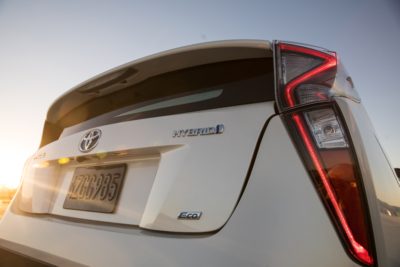 Downsides include rear passenger room, which is a bit tight. Sure, at almost 1/8 a ton, I don’t fit easily into anything, but I did find I had to maneuver a bit more than I cared to with the Prius (the Camry Hybrid is much more room in back).
Downsides include rear passenger room, which is a bit tight. Sure, at almost 1/8 a ton, I don’t fit easily into anything, but I did find I had to maneuver a bit more than I cared to with the Prius (the Camry Hybrid is much more room in back).
Another point of some frustration (for me, anyway) is that the dash display is not in front of you but centered on the dash between the driver and front passenger. It takes a while to get used to it, to be sure. When you start the Prius, you get a cool little cartoon of the car rolling along a road, and then all your information, to include battery usage, pops up and gets you ready for your journey. By having it center-stage on the dash, there is more room to display all the information about what is happening with your car every second you are in it. In many ways, having to move your eyes to the right to read the dash isn’t all that different from moving your eyes right to see what song is playing or what station you are enjoying. Just FYI, it is different and probably marks the way cars are going – we need more room for more information, and right smack in the center of the dash seems like prime real estate for doing that.
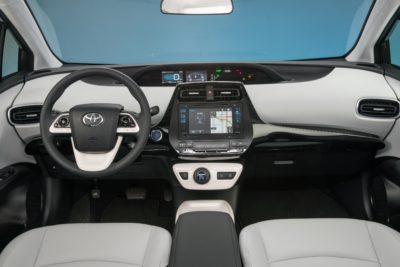 If a hybrid is your thing and you don’t care for an electric car, the Prius is your car. In fact, it really is just about your only option in the small to midsized sedan hybrid category. There’s comfort in knowing that it has always been a hybrid and not just a hybrid version of a gasoline inspired vehicle. At 56 miles per gallon, it may need little else to help it sell itself.
If a hybrid is your thing and you don’t care for an electric car, the Prius is your car. In fact, it really is just about your only option in the small to midsized sedan hybrid category. There’s comfort in knowing that it has always been a hybrid and not just a hybrid version of a gasoline inspired vehicle. At 56 miles per gallon, it may need little else to help it sell itself.
(There is, however, a modular plug-in battery system that will boost your mileage even further. This would be great for those of you that kinda almost want an electric car, but kinda don’t. Over and above 100 mpg might be possible. Click here for more details.)

